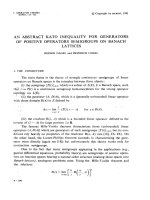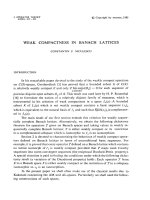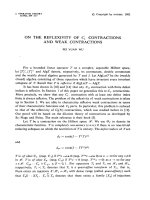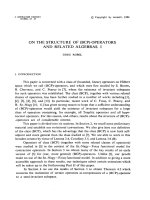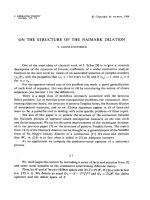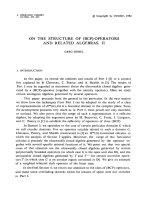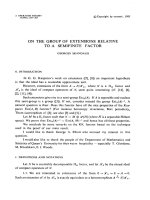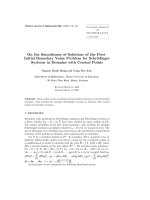Báo cáo toán học: "On the Energy of Unitary Cayley Graphs" pot
Bạn đang xem bản rút gọn của tài liệu. Xem và tải ngay bản đầy đủ của tài liệu tại đây (107.06 KB, 8 trang )
On the Energy of Unitary Cayley Graphs
H.N. Ramaswamy and C.R. Veena
Department of Studies in Mathematics, University of Mysore
Manasagangothri, Mysore 570 006, INDIA
, veena
Submitted: Mar 2, 2009; Accepted: Jul 17, 2009; Published: Jul 24, 2009
Mathematics Subject Classification: 05C50
Abstract
In this note we obtain the energy of unitary Cayley graph X
n
which extends a
result of R. Balakrishnan for power of a prime and also determine when they are
hyperenergetic. We also prove that
E(X
n
)
2(n−1)
≥
2
k
4k
, where k is th e number of distinct
prime divisors of n. Thus the ratio
E(X
n
)
2(n−1)
, measuring th e degree of hyperenergeticity
of X
n
, grows exponentially with k.
Keywords: Spectrum of a graph; Energy of a graph; Unitary Cayley graphs;
Hyperenergetic graphs.
1 Introduc tion
Let G be a simple finite undirected graph with n vertices and m edges and let A = (a
ij
)
be the adjacency matrix of g r aph G. The eigenvalues λ
1
, λ
2
, . . . , λ
n
of A, assumed in non-
increasing order, ar e the eigenvalues of the graph G called the Spect rum of G denoted by
Spec G. If the distinct eigenvalues of G are µ
1
> µ
2
> · · · > µ
s
, and their multiplicities
are m(µ
1
), m(µ
2
), . . . , m(µ
s
), then we write
Spec G =
µ
1
µ
2
. . . µ
s
m(µ
1
) m(µ
2
) . . . m(µ
s
)
.
Spec G is independent of labelling of t he vertices of G. As A is a real symmetric matrix
with zero trace, these eigenvalues are real with sum equal to zero.
The energy E(G) of G was defined by I. Gutman [6] in 1978 as the sum of the
absolute values of its eigenvalues.
the electronic journal of combinatorics 16 (2009), #N24 1
Since the energy of a graph is not affected by isolated vertices, we assume throughout
that graphs have no isolated vertices implying, in particular, that m ≥
n
2
. If a graph is
not connected, its energy is the sum of the energies of its connected components. Thus
there is no loss in generality in assuming that graphs are connected.
The complete graph K
n
has simple eigenvalue n − 1 and eigenvalue −1 of multiplicity
n−1. Thus its energy is given by E(K
n
) = 2(n−1). The graph G of order n whose energy
satisfies E(G) > 2(n−1) is called hyperenergetic and graph with energy E(G) ≤ 2(n−1)
is called non-hyper energetic.
The Line graph L(G) of a graph G is constructed by t aking the edges of G as vertices
of L(G), and joining two vertices in L(G) whenever the corresponding edges in G have a
common vertex. It is proved in [11] that the line graph of all k-regular graphs, for k ≥ 4,
are hyperenegetic.
Let Γ be a finite multiplicative group with identity 1. For S ⊆ Γ, 1 /∈ S and
S
−1
= {s
−1
: s ∈ S} = S, the Cayley graph X = Cay (Γ, S) is the undirected graph
having vertex set V (X) = Γ and edge set {(a, b) : ab
−1
∈ S}. By the right multiplication
Γ may be considered as a group of automorphisms of X acting transitively on V (X). The
Cayley graph X is a regular graph of degree |S|. Its connected components are the right
cosets of the subgroup generated by S. So X is connected, if S generates Γ.
For a positive integer n > 1 the unitary Cayley graph X
n
= Cay (Z
n
, U
n
) is defined
by the additive g r oup of the ring Z
n
of integers modulo n and the multiplicative group
U
n
of its units. If we represent the elements of Z
n
by the integers 0, 1, . . . , n − 1, then
U
n
= {a ∈ Z
n
: gcd (a, n) = 1}. So, X
n
has the vertex set V (X
n
) = Z
n
= { 0, 1, . . . , n −1}
and t he edge set {(a, b) : a, b ∈ Z
n
,
gcd (a − b, n) = 1}.
The concept of graph energy arose in theoretical chemistry. The total π-electron energy
of some conjugated carbon molecule, computed using H¨uckel theory, coincides with the
energy of its “molecular” graph. Recently there has been a tremendous research activity
in the areas like hyperenergetic gr aphs, maximum energy graphs, equienergetic graphs.
We refer to the survey papers by Gutman [7 ] and by Brualdi [3] for details. The study
of the energy of circulant gra phs is also of number theoretic interest as it is related to
the Gauss sum (see for instance [2], [9] and [10]). Cayley graphs are important class of
circulant graphs defined through finite groups. The unitary Cayley graphs have number
theoretic aspects as illustrated by Klotz and Sander [8 ] and Fuchs [5], wherein, the basic
invariants, the eigenvalues and the largest induced cycles were determined.
The energy of X
n
when n is a power of a prime was determined by Balakrishnan
[1] using the computations involving the cyclotonic polynomials φ
n
(x). In this note we
extend the result of Balakrishnan by obtaining the energy of all unitary Cayley graphs X
n
the electronic journal of combinatorics 16 (2009), #N24 2
and determine when they are hyperenergetic. We also obtain a lower bound for the ratio
of the energy of the unitary Cayley graph and the complete graph, thus measuring the
degree of hyperenergeticity. This ratio grows exponentially with the number of distinct
prime factors of n.
2. PRELIMINARIES
We give a brief account of some of the results of Klotz and Sander [8] on the eigenvalues
of unitary Cayley graphs which will be used in this not e.
It is well known that X
n
is a connected φ(n) - regular graph. If n = p is a prime
number, then X
n
is the complete graph on p vertices and if n = p
α
is a prime power, then
X
n
is a complete p - partite graph. The unitary Cayley graph X
n
, n ≥ 2, is bipartite
if and only if n is even. Klotz and Sander [8] have determined the chromatic number,
the clique number, the independence number, the diameter and the vertex connectivity
of X
n
. They have also shown that all nonzero eigenvalues of X
n
are integers dividing φ(n).
The eigenvalues of X
n
are given by
λ
r+1
=
1≤j <n,
gcd (j,n)=1
ω
rj
, 0 ≤ r ≤ n−1, (2.1)
where ω = exp(
2πi
n
). The sum in equation (2.1) is the well known Ramanujan sum c( r, n).
Thus, we have,
λ
r+1
= c(r, n), 0 ≤ r ≤ n − 1. (2.2)
The value of c(r, n) is an integer and so all the eigenvalues of X
n
are integers which are
given by:
c(r, n) = µ(t
r
)
φ(n)
φ(t
r
)
, where t
r
=
n
gcd (r, n)
, 0 ≤ r ≤ n−1, (2.3)
where µ denotes the M¨obius function. Klotz and Sander [8] have obtained the following
results:
Theorem 2.1 [8] For n ≥ 2, the following statements hold:
1. Every nonzero eigenvalue of X
n
is a divisor of φ(n).
2. Let m be the maximal squarefree divisor of n. Then
λ
min
= µ(m)
φ(n)
φ(m)
is a nonzero eigenvalue of X
n
of minimal absolute value and multiplicity φ(m).
Every eigenvalue of X
n
is a multiple of λ
min
. If n is odd, then λ
min
is the only
nonzero eigenvalue of X
n
with minimal absolute value. If n is even, then −λ
min
is
also an eigenvalue of X
n
with multiplicity φ(m).
the electronic journal of combinatorics 16 (2009), #N24 3
Theorem 2.2 [8] Let m be the maximal squarefree divisor of n and let M be the set
of positive divisors of m. Then the following statements for the unitary Cayley graph
X
n
, n ≥ 2, hold:
1. Repeating φ(t)-times every term of the sequence S =
µ(t)
φ(n)
φ(t)
t∈M
results in a
sequence
˜
S of length m which consists of all nonzero eigenvalues of X
n
such that
the number of appearances of an eigenvalue is its multiplicity.
2. The multiplicity of zero as an eigenvalue of X
n
is n − m.
3. If α(λ) is the multiplicity of the eigenvalue λ of X
n
, then λα(λ) is a multiple of
φ(n).
3. ENERGY OF UNITARY CAYLEY GRAPHS
We first give a direct proof of the result of Balakrishnan [1] when n is a power of a
prime.
Theorem 3.1. If n = p
α
is a prime power, then the energy of the unitary Cayley
graph X
n
is given by E(X
n
) = 2φ(n).
Proof. When α = 1, the graph X
n
is the complete graph K
p
. Clearly E(K
p
) = 2(p−1) =
2φ(p). Hence we can assume α ≥ 2 .
The eigenvalues of the unitary Cayley graph X
p
α
are given by
λ
r+1
= c(r, p
α
) = µ(t
r
)
φ(p
α
)
φ(t
r
)
, where t
r
=
p
α
gcd(r, p
α
)
, 0 ≤ r ≤ p
α
− 1.
We consider three cases:
Case(1): If gcd(r, p
α
) = p
α
then r = 0 and so t
0
= 1. Hence λ
1
= φ ( p
α
) = p
α
− p
α−1
.
Case(2): If gcd (r, p
α
) = 1 then t
r
= p
α
and hence we get λ
r+1
= 0.
Case(3): If 1 < gcd(r, p
α
) < p
α
then g cd(r, p
α
) = p
m
, where 1 ≤ m ≤ α − 1. When
gcd(r, p
α
) = p
α−1
, we get λ
r+1
= −p
α−1
. For all other remaining values of m
we get λ
r+1
= 0.
Therefore t he Spectrum of X
p
α
is
Spec X
p
α
=
p
α
− p
α−1
−p
α−1
0
1 p − 1 p
α
− p
.
Thus, E(X
p
α
) = p
α
− p
α−1
+ (p − 1)p
α−1
= 2(p
α
− p
α−1
) = 2φ(p
α
).
Hence the proof.
Let G
1
= (V
1
, E
1
) and G
2
= (V
2
, E
2
) be graphs. The direct product of G
1
and G
2
is the graph G = (V, E) denoted by G
1
⊗ G
2
(also by G
1
∧ G
2
) where V = V
1
× V
2
, the
the electronic journal of combinatorics 16 (2009), #N24 4
cartesian product of V
1
and V
2
, with (v
1
, v
2
) and (u
1
, u
2
) are adjacent in G if and only if
v
1
, u
1
are adjacent in G
1
and v
2
, u
2
are adjacent in G
2
.
Theorem 3.2. If (m, n) = 1, then the direct product of the unitary Cayley graphs
X
m
and X
n
is isomorphic to X
mn
.
Proof. Since (m, n) = 1, by the Chinese Remainder theorem, there is an isomorphism
φ : Z
m
× Z
n
−→ Z
mn
. This isomorphism induces an isomorphism between their g roups
of units U
m
× U
n
and U
mn
. Let k
i,j
be the element in Z
mn
corresponding to the element
(i, j) ∈ Z
m
× Z
n
. Then (i, m) = 1 = (j, n) if and only if (k
i,j
, mn) = 1. The vertex
set of X
mn
is Z
mn
and the vertex set of X
m
× X
n
is Z
m
× Z
n
. The isomorphism φ
gives the bijective correspondence between their vertex sets. Let i
1
be adjacent to i
2
in X
m
and let j
1
be adjacent to j
2
in X
n
. Then (i
1
− i
2
, m) = 1 = (j
1
− j
2
, n). Now
consider k
i
1
,j
1
, k
i
2
,j
2
∈ Z
mn
. Since φ is an isomorphism, k
i
1
−i
2
,j
1
−j
2
= k
i
1
,j
1
− k
i
2
,j
2
. Now
(k
i
1
−i
2
,j
1
−j
2
, mn) = 1 and so k
i
1
,j
1
and k
i
2
,j
2
are adjacent in X
mn
.
Conversely, if k
i
1
,j
1
is adjacent to k
i
2
,j
2
in X
mn
, then, k
i
1
−i
2
,j
1
−j
2
= k
i
1
,j
1
− k
i
2
,j
2
∈ U
mn
and so i
1
− i
2
∈ U
m
and j
1
− j
2
∈ U
n
. Thus i
1
is adjacent to i
2
in X
m
and j
1
is
adjacent t o j
2
in X
n
. Hence X
m
⊗ X
n
and X
mn
are isomorphic. This completes the proof.
Corollary 3.3. If n = p
α
1
1
p
α
2
2
. . . p
α
k
k
, then the direct product of unitary Cayley graphs
X
p
α
1
1
⊗ X
p
α
2
2
⊗ · · · ⊗ X
p
α
k
k
is isomorphic to X
n
.
Definition 3.4. The tensor product A ⊗ B of the r × s matrix A = (a
ij
) and the
t × u matrix B = (b
ij
) is defined as the rt × su matrix got by replacing each entry a
ij
of
A by the double array a
ij
B.
It is easy to check that for any two graphs G
1
and G
2
the adjacency matrix A(G
1
⊗G
2
)
of G
1
⊗ G
2
is given by
A(G
1
⊗ G
2
) = A(G
1
) ⊗ A(G
2
).
Lemma 3.5. [4] If A is a matrix of order r with Sp ectrum {λ
1
, λ
2
, . . . , λ
r
}, and B,
a matrix of order s with Spectrum {µ
1
, µ
2
, . . . , µ
s
}, then the spectrum of A ⊗ B is
{λ
i
µ
j
: 1 ≤ i ≤ r; 1 ≤ j ≤ s}.
Corollary 3.6. If G
1
and G
2
are any two graphs, then,
E(G
1
⊗ G
2
) = E(G
1
)E(G
2
).
Theorem 3.7. If n > 1 is of the form n = p
α
1
1
p
α
2
2
. . . p
α
k
k
where p
1
, p
2
, . . . , p
k
are distinct primes and α
1
, α
2
, . . . , α
k
are positive integers, then,
E(X
n
) = 2
k
φ(n).
Proof. By Corollary 3.3, X
n
is isomorphic to the product X
p
α
1
1
⊗ . . . ⊗ X
p
α
k
k
. Now by
Corollary 3 .6 , the energy of the direct product of graphs is the product of their energies.
Hence, it follows that, E(X
n
) = E(X
p
α
1
1
) . . . E(X
p
α
k
k
). Now by Theorem 3.1, E(X
p
α
i
i
) =
2φ(p
α
i
i
) for 1 ≤ i ≤ k and so we have,
the electronic journal of combinatorics 16 (2009), #N24 5
E(X
n
) = 2
k
φ(p
α
1
1
) . . . φ(p
α
k
k
)
= 2
k
φ(p
α
1
1
. . . p
α
k
k
)
= 2
k
φ(n), since φ is multiplicative.
Corollary 3.8.
E(X
n
)
2(n − 1)
> 2
k−1
φ(n)
n
.
We note that if n = p
α
1
1
p
α
2
2
. . . p
α
k
k
, then,
φ(n)
n
=
1 −
1
p
1
1 −
1
p
2
. . .
1 −
1
p
k
.
This will be used in the characterization of hyperenergetic unitary Cayley graphs. First
we state the following Lemma whose proof follows by induction and is elementary.
Lemma 3.9. For k ≥ 3 and n = p
α
1
1
p
α
2
2
. . . p
α
k
k
, we have,
φ(n)
n
>
1
2
k−1
.
By making use of the Theorem 3.7, we now characterise the hyperenergetic unitary Cayley
graphs.
Theorem 3.10 Let n = p
α
1
1
p
α
2
2
. . . p
α
k
k
where p
1
, p
2
, . . . , p
k
are distinct prime divisors
of n. Then the unitary Cayley graph X
n
is hyperenergetic if and only if k ≥ 3 or k = 2
and n is odd.
Proof. We consider three cases:
Case 1: For k = 1, n = p
α
, if X
n
is hyperenergetic then, we have,
2φ(p
α
) > 2(p
α
− 1) ⇒ 2(p
α
− p
α−1
) > 2(p
α
− 1)
i.e., 2 > 2p
α−1
⇒ 1 > p
α−1
which is impossible.
Therefore X
n
is not hyperenergetic.
Case 2: For k = 2, n = p
α
q
β
(p < q).
Here we consider two subcases:
(i) p = 2, n = 2
α
q
β
, 2 < q
Then, we have,
E(X
n
) = 4φ(n) = 4 · 2
α−1
q
β−1
(q − 1)
= 2 n
q − 1
q
< 2 n
n − 1
n
= 2(n − 1).
Therefore X
n
is non-hyperenergetic.
the electronic journal of combinatorics 16 (2009), #N24 6
(ii) p ≥ 3, q ≥ 3, p < q
Since q ≥ 5, we have, E(X
n
) > 2n.
Therefore X
n
is hyperenergetic.
Case 3: Let k ≥ 3. If n = p
α
1
1
p
α
2
2
. . . p
α
k
k
, then, by Corollary 3.8 and Lemma 3.9, we
have,
E(X
n
)
2(n − 1)
> 1,
and so X
n
is hyperenergetic.
This completes the proof of the theorem.
In the next theorem we show that the degree of hyperenergeticity grows at least
exponentially with t he number of distinct prime divisors of n by making use of the sharper
lower bound for
φ(n)
n
, namely
φ(n)
n
>
1
2k
.
Theorem 3.11. Let k denote the number of distinct prime divisors of n. Then
E(X
n
)
2(n − 1)
>
2
k
4k
.
Proof. Let n = q
α
1
1
. . . q
α
k
k
where q
1
, . . . , q
k
are distinct primes such that
q
1
< q
2
< . . . < q
k
. When k = 1, we have, n = q
α
and so
E(X
n
)
2(n − 1)
=
2φ(n)
2(n − 1)
>
φ(n)
n
=
1 −
1
q
≥
1
2
.
Suppose k ≥ 2. Let p
j
denote the j
th
prime. Then clearly p
j
≥ 2j − 1 for j ≥ 2. Thus
1 −
1
q
j
≥ 1 −
1
p
j
≥
2j − 2
2j − 1
.
Hence,
φ(n)
n
≥
1
2
·
2
3
·
4
5
·
6
7
· · ·
2k − 2
2k − 1
≥
1
2k − 1
>
1
2k
.
Now the result follows from Corollary 3.8.
Acknowledgement
The authors thank t he referee for helpful comments and useful suggestions.
the electronic journal of combinatorics 16 (2009), #N24 7
References
[1] R. Balakrishnan, The energy of a graph, Linear Algebra Appl. 387 (2004) 287-295.
[2] S.R. Blackburn, I. Shparlinski, On the average energy of circulant graphs, Linear
Algebra Appl. 428 (2008) 1956-1963.
[3] R.A. Brualdi, Energy of a graph, Notes to AIM Workshop on spectra of families of
matrices described by graphs, digraphs, a nd sign patterns, 2006.
[4] D. Cvetkovi´c, M. Doob, H. Sachs, Spectra of Graphs - Theory and Applications,
Academic Press, New York, 1980 .
[5] E.D. Fuchs, Largest induced cycles in circulant graphs, The Electronic Journal of
Combinatorics, 12 (2005), 1-12.
[6] I. Gutman, The energy of a graph, Ber. Math. -Stat. Sekt. Forschungszent. Graz 103
(1978) 1-22.
[7] I. Gutman, The energy of a graph: old and new results in : A. Bitten, A. Koher,
R. Laue and A. Wassermann (Eds.), Algebraic Combinatorics and Applications,
Springer-Verlag, Berlin 2001, 196-211.
[8] W. Klotz, T. Sander, Some properties of unitary Cayley graphs, The Electronic
Journal of Combinatorics, 14 (2007) 1-12.
[9] I. Shparlinski, On the energy of some circulant graphs, Linear Algebra and Appl.,
414 (2006), 378-382
[10] D. Stevanonic a nd I. Stankovic, Remarks on hyperenergetic circulant graphs, Linear
Algebra and Appl., 400 (2005), 345-348.
[11] H.B. Walikar, I. Gutman, P.R. Hampliholi, H.S. Ramane, Non-hyperenergetic graphs,
Graph Theory Notes N.Y. 51 (2001) 14-1 6.
the electronic journal of combinatorics 16 (2009), #N24 8


